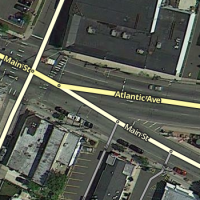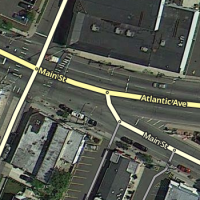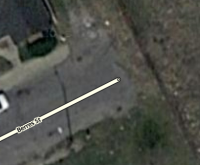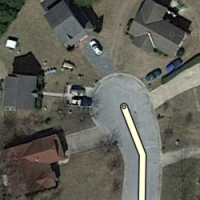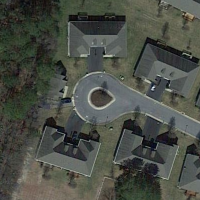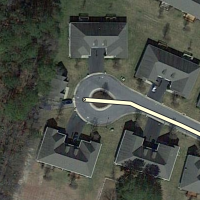Sem resumo de edição |
Sem resumo de edição |
||
| Linha 293: | Linha 293: | ||
<!--T:91--> | <!--T:91--> | ||
==== | ==== Bifurcarção de Rodovias/Expressas ==== <!--T:92--> | ||
Uma bifurcação de Rodovia/Expressa ocorre quando um segmento de rodovia/expressa divide-se em um nó de junção em duas rodovias/expressas no qual não é possível dar uma instrução de direção para seguir em frente. | |||
===== | ===== Estrutura ===== | ||
: [[Image:Jct_fwy_fwy_split.png]] | : [[Image:Jct_fwy_fwy_split.png]] | ||
<!--T:93--> | <!--T:93--> | ||
Para receber instruções corretas em '''ambas''' as direções da bifurcação as seguintes condições são necessárias: | |||
# | # Todos os segmentos devem ser do tipo Rodovia/Expressa | ||
# | # Todos os segmentes devem ter nomes diferentes | ||
# | # O ânugulo dos segmentos de saida deve ser entre 20 e 30 graus do ângulo do segmento de entrada | ||
<!--T:94--> | <!--T:94--> | ||
Quando estás condições forem satisfeitas, a junção dará as intruções "Mantenha a esquerda" e "Mantenha a direita" usando o nome do segmento de saida. | |||
===== | ===== Nomeclatura ===== <!--T:95--> | ||
<!--T:96--> | <!--T:96--> | ||
A principal condição é que os 3 segmentos no nó de junção precisam ter nomes diferentes. Isto pode ser obtido das seguintes maneiras: | |||
# | # Usando simplesmente os nomes das estradas - Esse é o caso que a Estrada A se divide nas Estradas B e C | ||
# ????? | |||
# Using signs and [[#Wayfinder_Segments|Wayfinder Segments]] - If one of the branches of the split has the same name as the entering segment, we must create uniqueness at the junction. If "Highway X" splits off from "Highway Y" and "Highway X" continues as the other branch, the preferred approach is to use named [[#Wayfinder_Segments|Wayfinder Segments]]. | # Using signs and [[#Wayfinder_Segments|Wayfinder Segments]] - If one of the branches of the split has the same name as the entering segment, we must create uniqueness at the junction. If "Highway X" splits off from "Highway Y" and "Highway X" continues as the other branch, the preferred approach is to use named [[#Wayfinder_Segments|Wayfinder Segments]]. | ||
# ?????? | |||
==== Wayfinder Segments ==== <!--T:97--> | ==== Wayfinder Segments ==== <!--T:97--> | ||
Edição das 05h46min de 3 de dezembro de 2018
O artigo abaixo contém informações muito importantes em como criar corretamente cruzamentos no Brasil. Por favor, leia atentamente este artigo antes de editar junções.
Simples é melhor
Quando se cria junções (interseções, encruzilhadas, junções em formato T, etc) às vezes temos que adaptar o formato real para que ele seja o mais útil possível no Waze. A ideia principal seria representar o cruzamento da maneira mais simples possível e somente incluir complexidade quando estiver lidando com um problema específico.
Dica: Quando a resposta de um problema que você tiver não for respondida por este artigo ou você ainda estiver com dúvidas, entre em contato no Forum da comunidade de Editores Brasileira.
O Básico
O que é uma junção?
Uma junção é composta de três itens:
- Pelo menos duas ruas;
- Um ponto onde as ruas se encontram (nó de junção)
- Curvas permitidas ou não de uma rua para a outra através do nó de junção
Se você não sabe como criar e modificar as vias, estradas, cruzamentos, etc. Por favor leia the Map Editing Quick-start Guide.
Encontro de vias
Vamos começar com a situação básica de final de rua. A rua que esta terminando vai acabar na rua principal em um ângulo de 90 graus. Esse é o exemplo mais simples no mapa já que o formato real da rua é desenhado exatamente igual no Waze.
Você achará muitas ruas que se encontram com ângulos diferentes. Até em áreas urbanas projetadas você encontrará ruas antigas que não seguem o projeto, passando no meio de centros urbanos em ângulos estranhos. A ideia inicial seria criar no mapa o mesmo ângulo que na vida real, mas isso deve ser feito com cuidado já que, na maioria dos casos, o ângulo de entrada ou saída influenciam diretamente as instruções de navegação.
Esse método possui algumas falhas. Dependendo do ângulo (mas não exclusivamente dele) o Waze poderá dar instruções de "Mantenha à Direita" enquanto a instrução "Vire à Direita" seria a mais indicada. Se as saídas forem de Minors, Major ou Freeway a instrução será "Saia à Direita" onde, em alguns casos, pode ser confusa. Em alguns casos nenhuma instrução será dada.
Para eliminar ambiguidade, nos precisamos desenhar o cruzamento aonde o algoritmo de roteamento funcione da melhor maneira possível.
Uma rampa saindo de uma auto estrada dará o comando Saia, então o seu ângulo de saída não é necessariamente um problema.
Cruzamentos
Quando fizer uma curva em um cruzamento, a ideia é receber as instruções "vire à esquerda" ou "vire à direita", neste caso esperaremos ângulos próximos a 90 graus.
Se tivermos uma rua cruzando em um ângulo muito diferente de 90 graus, nós precisamos fazer com que o algoritmo identifique que desejamos "vire" em vez de "mantenha".
Ruas em mesmo Nível
Intersecções em Y
Quando ruas em mesmo nível se encontram como uma figura em Y, precisamos cuidadosamente mapear os segmentos para fornecer direções por voz úteis. Como explicado em How Waze Determines turn/keep/exit maneuvers, nomes de segmentos e geometria são importantes para determinar qual instrução será dada.
No exemplo abaixo a pista principal muda de nome ao se dividir em Y, para oeste ela é chamada de Main St e para leste como Atlantic Ave.
No entanto na figura abaixo a rua Main St. foi mapeada como sendo uma reta e a Atlantic Ave. como uma rua saindo da outra avenida, neste caso instruções por voz serão dadas de forma incorreta.
Como a rua principal e a rua secundária possuem o mesmo nome, o sistema de roteamento considera a rota com o mesmo nome de ruas entre segmentos como sendo "mantenha", enquanto a saida para a rua de nome distinto como "vire". Na figura acima reforçamos para o servidor de rotas que este pensamento está correto ao deixarmos os segmentos encontrando-se de forma reta.
O motorista que quiser seguir em frente na rua principal quer receber o comando para continuar em frente independentemente da mudança de nome da rua. Para que o sistema de roteamento forneça as intruções corretas é necessário que os segmentos sejam segundo a figura abaixo:
Now the geometric definition of straight is the multi-lane portion of Main St. onto Atlantic Ave., since we have made that transition as close to zero degrees as possible. The regular street portion of Main St. now branches off at an angle close to 90 degrees. The routing engine should recognize that a turn is required. So the result is that Main St. to Atlantic Ave. has no announced turn, and multi-lane Main St. to surface road Main St. has a turn announced. Exactly what most drivers would expect in the real world.
Ruas Sem Saída
Ruas que só tem um nó para entrar e a saida é pelo mesmo nó inicial podem representar desafios para o servidor de rotas, apesar de serem bem simples no nosso entendimento.
Ruas Sem Saída são segmentos de vias que simplesmente terminam, sem continuação ou conexão em uma de suas pontas. Uma placa de "Sem saída" pode indicar que a rua tem uma ou mais conexões para outros segmentos que não tem saida.
Dentro do Editor de Mapas não é possível representar uma Rua Sem Saída com múltiplos segmentos se existirem ruas privativas ou de estacionamento mapeadas e conectadas. Nesse caso somente o último segmento é considerado "sem saída".
Assegure-se de que ali exista um nó (não apenas uma "dobra") no extremo final do segmento. Isso é necessário para garantir o roteamento pra fora desse segmento. Veja a seção "Cul-de-sac" abaixo para saber quando e como corrigir.
O nó final deve ser localizado no fim da rua. No entanto, o Waze só considera o segmento como tendo sido atravessado se os nós em ambas as pontas do segmento tiverem sido atravessados, se o nó final estiver em cima da calçada ou muito próximo do fim da rua o sistema não irá considerar o segmento como tendo sido atravessado. A regra mais simples e colocar o nó final equidistantemente das calçadas e do fim da rua.
O nó como feito na figura acima permite o Waze identificar que aqueles com destino no fim da rua sejam adequadamente identificados como tendo atravessado o segmento.
Em ruas residências as ruas sem saida podem ter uma área circular ou uma praça no final. Na maior parte das situações essas ruas devem ser tratadas da mesma maneira que ruas sem saida.
O nó deve ser localizado próximo do centro do circulo, não próximo das calçadas.
As ruas sem saida como uma praça devem ser tratadas da mesma maneira que as ruas sem saida normais.
Nesse caso o nó deve ser colocado no fim da rua e não no centro da praça.
Loops
Loops são estradas em que você pode entrar e, sem inverter a mão de direção, terminará no mesmo local onde você estava.
Uma regra importante do Editor de Mapas é: um segmento de via não deve começar e terminar na mesma junção.
Se essa regra não for seguida, o servidor de rotas terá dificuldades em fornecer trajetos para dentro e fora do loop. Qualquer loop partido em dois segmentos por uma junção não terá este problema.
Pode-se esperar que haverá outra estrada ao longo do loop a qual você possa mapear, e que irá quebrar o loop em duas partes. Se não houver esse tipo de quebra e todo o loop for representado por um segmento que se conecta consigo mesmo, devemos inserir uma junção supérflua em um dos segmentos que integram a estrutura. A posição da junção extra não importa, mas a maioria das pessoas colocam na metade de um dos segmentos.
Exemplo do problema causado: principalmente em vias em que rotas passam por elas, a não observação desta regra pode gerar instruções erradas e completamente sem sentido para o motorista, pois a rota desenhada no mapa mostra um caminho, mas a instrução, no passo-a-passo e falada, é outra. Veja o exemplo abaixo, onde a rota correta e desenhada passa pelo trecho à esquerda, mas a instrução, mostrada pela plaquinha (seta), mostra "manter à direita" (!):
NOTA É muito fácil um editor encontrar a junção extra, assumir que é supérflua e deletá-la! Esse problema é maior se a estrada que forma o loop for muito grande ou de forma irregular, logo o loop não será facilmente notado. Uma solução é identificar um caminho ou estrada que ramifique do loop e adicioná-la ao mapa, criando uma junção de três vias com menores chances de ser deletada.
NOTA O Editor de Mapas pode ser resistente em editar um loop que ainda não foi quebrado em dois. Caso ocorra erros ao salvar, tente uma das seguintes abordagens:
Se o loop e a estrada que chega até ele possuem o mesmo nome:
- Selecione a via e o loop
- clique no ícone de ponte que aparece (uma terminação do loop irá desconectar da outra)
- divida o loop
- reconecte as terminações desconectadas
- confirme conversões
Se o loop e o segmento que chega até ele têm nomes diferentes
- desenhe um novo segmento que se conecte ao loop/junção
- dê ao segmento novo o mesmo nome que o do loop
- selecione o loop e o novo segmento
- clique no ícone de ponte que aparece (uma terminação do loop irá desconectar da outra)
- divida o loop
- reconecte a terminação desconectada do loop
- confirme conversões
Este é um video no YouTube mostrando o segundo método (em inglês).
Rotatórias e Retornos Circulares
Por favor, veja a página Criando e Editando uma Rotatória, a qual contém uma descrição completa deste tipo de junção especial.
At-Grade Connectors
Don't set these segments as ramps! Watch out for all of the turns you need to restrict. For a full discussion, see the at-grade connectors page.
Rampas
Ramps have a very specific purpose in Waze. They are intended to connect segments of Minor Highways, Major Highways, and Freeways to roads where there are no at-grade crossings.
Quando usar rampas
The following conditions must be met for the use of ramps to be appropriate:
- Two roads cross over/under each other with no at-grade junction
- At least one of the roads are of these types
- Minor Highway
- Major Highway
- Freeway
- Ramp
If the above requirements are not satisfied, you may be dealing with an At-Grade Connector.
Quão complexas as rampas devem ser?
Rule #1 is still simpler is better. If there is no large distance between paths at the end of a ramp (either into or out of the ramp), a single segment connecting to a single junction node is all that is needed. The existence of a painted, concrete, or grass island is NOT enough of a reason to split a ramp into multiple ramps.
When paths at the end of the ramp deviate significantly in distance, regardless of the existence of any type of island, then multiple ramps should be used.
Junções em Rodovias/Expressas
Essas são junções envolvendo os 3 tipos de rodovias (estadua/federal/expressa) e as rampas.
Exemplos especificos serão dados nas seções posteriores. Todos os exemplos usam as partes basicas apresentadas aqui.
Se não tem certeza de qual tipo de rua utilizar, consulte a seguinte página para informações
Saidas de Rodovias/Expressas
São situações tipicas de rodovias retas quando a direção "seguir em frente" de maneira reta é obvia para o motorista, nesse caso instruções só são necessárias para a direção não reta (a saida). Se instruções forem necessarias para ambos os caminhos consulte a seção Wayfinder Segments abaixo.
Estrutura
Para ser considerado um tipo básico de saida as condições seguintes devem ser satisfeitas:
- O segmento de entrada e o segmento de saida devem ser do tipo rodovia
- O segmento rodovia de saida deve ter um angulo próximo de zero graus em relação ao segmento de entrada
- O segmento de saida deve ser do tipo rampa
- O angulo do segmento de saida deve ter entre 20 e 30 graus do segmento de entrada
Se estas condições forem satisfeitas a instrução "saia a esquerda/direita" será fornecido para a saida da rodovia e nenhuma instrução será dada para seguir em frente.
Nomeclatura
Os segmentos de rodovia/expressa devem ter o mesmo nome antes e depois do nó de junção. A rampa deve seguir a regra especifica para rampas.
Bifurcarção de Rodovias/Expressas
Uma bifurcação de Rodovia/Expressa ocorre quando um segmento de rodovia/expressa divide-se em um nó de junção em duas rodovias/expressas no qual não é possível dar uma instrução de direção para seguir em frente.
Estrutura
Para receber instruções corretas em ambas as direções da bifurcação as seguintes condições são necessárias:
- Todos os segmentos devem ser do tipo Rodovia/Expressa
- Todos os segmentes devem ter nomes diferentes
- O ânugulo dos segmentos de saida deve ser entre 20 e 30 graus do ângulo do segmento de entrada
Quando estás condições forem satisfeitas, a junção dará as intruções "Mantenha a esquerda" e "Mantenha a direita" usando o nome do segmento de saida.
Nomeclatura
A principal condição é que os 3 segmentos no nó de junção precisam ter nomes diferentes. Isto pode ser obtido das seguintes maneiras:
- Usando simplesmente os nomes das estradas - Esse é o caso que a Estrada A se divide nas Estradas B e C
- ?????
- Using signs and Wayfinder Segments - If one of the branches of the split has the same name as the entering segment, we must create uniqueness at the junction. If "Highway X" splits off from "Highway Y" and "Highway X" continues as the other branch, the preferred approach is to use named Wayfinder Segments.
- ??????
Wayfinder Segments
It may be necessary to provide additional information to a driver for complex or confusing Exits and Splits. Examples of such situations include:
- Lane Drops - Highway has been 3 lanes for miles and miles but only 2 lanes continue straight through at a certain point
- Inconsistent signage - Highway continues as a numbered route, but signs only call it by a name instead
- Non-obvious continuations - In a right-hand traffic country, exiting traffic is to the left and continuing traffic is to the right
In these cases we need to use short way-finder or path-finder segments which are named with the information displayed on the roadway signs. There are two methods to accomplish this: using Highway/Freeways or using Ramps.
- Highway/Freeways
- Pro: provide a consistently rendered line on the map with no breaks
- Pro: does not introduce a routing penalty for the transition to Ramp type (although we do not know how much of an impact, if any, this has in actuality)
- Con: the long name of the segment may be displayed on the map creating clutter
- Con: the segment may be hard to see in the editor since it may blend in with the main Freeway
- Note: will provide "Keep Left" and "Keep Right" instructions
- Ramps
- Pro: ensures any long names are hidden from display on the map
- Pro: forces the client to stay zoomed in for the length of the segment to give a close view of the split to the driver
- Con: introduces a routing penalty of the transition to Ramp type (although we do not know how much of an impact, if any, this has in actuality)
- Con: may render as a broken line on the map
- Note: will provide "Keep Left" and "Exit Right" instructions in right-hand traffic countries and "Exit Left" and "Keep Right" instructions in left-hand traffic countries.
In both cases, the two exiting segments MUST have identical road types and different names from themselves and the entering segment.
Here we show Highway Y splitting off from Highway X. By labeling segments with the information available on the road signs at the split, we have achieved uniqueness and provided additional useful information (the destination cities) to the driver. We can achieve the desired results using either approach. First as all Freeway segments:
And then using Ramps (which are named how they appear in the all Freeway example):
At times it is also necessary to use a way-finder at an Exit if a driver needs advance notice that only some lanes of the roadway continue straight through. Again we can accomplish this using either of the two methods. First using Freeway segments for the split:
And then using Ramps (again, named the same as above):
A rule of thumb for the way-finder segments is to make them 15 to 20 meters long. This keeps the segment small so we are less likely to see it in the client, but keeps it long enough to find and manipulate in the map editor.
Ramp to Ramp Splits
A ramp may itself split and branch into two directions. If this is the case, "Exit Right" and "Exit Left" will be announced using the name of the appropriate exiting segment in all cases.
Structure
Naming
If ramps are unnamed, the name of a subsequent ramp will propagate backwards. In the example above, if the two ramps exiting the junction are named, the ramp entering the junction can be left unnamed. Then any navigation instruction directing you onto the first ramp would use the name of the appropriate exiting ramp.
Example: The two ramps exiting the junction are named "DestinationLeft" and "DestinationRight". The ramp that enters the junction is unnamed. If you need to "Exit Right" onto the unnamed ramp. If you are headed to "DestinationLeft", navigation would tell you:
- Exit Right to Destination Left
- Exit Left to Destination Left
Using unnamed ramps is very useful to provide sufficient notification of an approaching decision point, as long as the names of both ramp splits are visible on signs at the start of the initial ramp.
Example of good use of unnamed ramps:
- Initial Exit Sign: to City A and City B
- Destination Left Sign: to City A
- Destination Right Sign: to City B
Result: An unnamed initial ramp will provide accurate and informative navigation instructions to the driver.
Example of poor use of unnamed ramps:
- Initial Exit Sign: to Downtown
- Destination Left Sign: to Downtown
- Destination Right Sign: to Center St
Result: An unnamed ramp may create confusion since both Destination ramp names are NOT listed on the initial exit sign. In this case the initial ramp should be named.
Example of modified use of unnamed ramps:
- Initial Exit Sign: Exit 70A-B to City A and City B
- Destination Left Sign: to City A
- Destination Right Sign: to City B
- Destination Left name in Waze: Exit 70A: City A
- Destination Right name in Waze: Exit 70B: City B
Result: By using a modified name for the destination ramps, we have combined information from two sets of signs to generate the advance notice a driver may need to prepare for a decision point.
Limited Access Interchanges
Please see the Limited Access Interchange Style Guide.
Special Cases
Transitions
A transition is a non-junction depicted using a junction node.
Valid examples of where to use a Transition node include:
- Road name changes
- City Limits
- Road Direction changes
- Part of a Loop Road
An old reason to use a transition node was to indicate segments of the road with different house numbering. With the new point numbering scheme being adopted by Waze, this is no longer a reason to use transition nodes.
There may be existing Transition nodes on the map for other reasons (left after a connecting road was deleted, inherited from to the original base map import when things such as rivers and streams created junctions, etc.).
As long as we are certain it is not a valid Transition node, a superfluous junction node may be deleted. Doing so will simplify the map, eliminate turn restrictions to maintain, and reduce computing resource needs. Also consider removing the geometry node which will replace the junction node you delete, if that geometry node is not needed.
Roads to Nowhere
In certain situations it may be necessary to add road segments that are un-drivable in order to provide accurate navigation instructions.
Actual
A valid use of this technique is at the temporary end of a freeway. As a freeway is built, it is often opened in sections, up to a certain exit. If we map this as a regular freeway segment leading to a ramp segment, no announcement will be made for that final exit, no matter what we name the exit ramp.
This can be confusing if the ramp is set up as a properly signed and numbered exit, especially if a driver is traveling a long distance on this freeway. Imagine traveling down a freeway and seeing your next instruction is "turn left at Main St." You would probably wonder if there was a map error since you shouldn't be making left turns off of a freeways.
If we map even just a little of the future path of the freeway, this gives the routing engine a junction which will generate an "exit" instruction at the end of the freeway, thus eliminating any confusion.
Conversely, if we do NOT want an exit instruction at the end of a freeway, ensure there are no road segments extending past the final exit, to ensure the final exit is the only path out of the final freeway segment.
Fake
(coming soon)
Offset Roads
Sometimes you will find two roads which cross, where one does not quite line up with the other.
There are a few things we need to look at in this situation.
- Do the roads actually line up in reality? If so we need to modify the junction to be a basic 4-way junction.
- Do the roads ALMOST line up in reality? If you were giving instructions to a person and would tell them to go straight with no mention of any slight turn or jog, then we want to make it into a 4-way junction. You may need to "split the difference" and not follow the centerline of either road to achieve this. The angles are exaggerated in this next example to show how the junction is forced to be close to 90 degrees, then we taper to the true centerlines of the roads. In practice this can be much more gradual and/or done while zoomed in very close.


- Finally, is there a true separation between the roads? Would you need to say for example "turn left then make an immediate right"? If so then we will want to leave the junction such that the two sides do not align.

Since we want to avoid very short segments of road (the GPS chips in consumer devices can be very inaccurate which may make it seem that a driver skipped right over a short segment. This will result in automated map errors and possible route recalculations in the client,) it may be wise to shift the side roads as far apart from each other as possible with them still in the proper location (along the far curb lines for a residential street for example). This will maximize the length of the short segment between the side roads.














